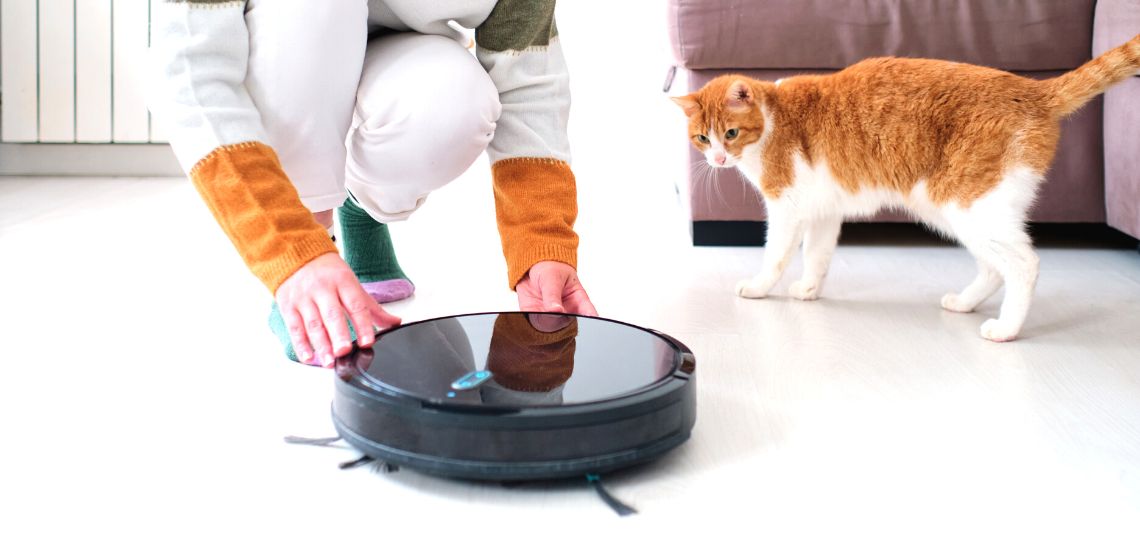Table of Contents
Pets bring so much joy to our lives and although they’re not always the cleanest members of the family, we love them just the same. Check out this pet-friendly spring cleanup checklist to help make cleaning up after your furry friends a breeze!
Step 1: Get Organized!
Before you even start cleaning, take the time to sit down and organize your spring cleaning plans. This can include things like scheduling time for cleaning, making a to-do list, dividing tasks by room or level of difficulty, and more. By having everything written out and detailed, this will keep cleaning efficient and organized while keeping you motivated to cross items off your list and have time to enjoy your new, clean space.
Make a To-Do List
One of the most important things you can do before you even start cleaning is to write everything down in a to-do list. This will help you stay on top of tasks and set long-term goals for healthy cleaning habits. Some tips for creating a Spring Cleaning To-Do List include:
- Dividing tasks up by sections based on the amount of time each project will take or by each room in the house
- Using a color coding system to make your list visually appealing and easy to follow
- Setting a timeline for each item on the checklist
Having everything written down and organized will keep you motivated and help ensure that nothing is overlooked when it comes to spring cleaning!
Focus on One Area at a Time
We all know that life gets the best of us sometimes and cleaning can often take a backseat as families focus on taking time out for each other. When it comes time for spring cleaning, it can often be overwhelming as the list of chores seems to be never ending, but breaking cleaning down by room can help make everything more bearable! Dividing tasks by room helps set attainable goals and highlights the progress being made throughout the cleaning phase.
Step 2: Gather Your Supplies
When it comes to cleaning up after pets, household cleaners are a great first line of defense against messes but aren’t always the safest or most reliable option for dealing with dirt, dander, and pet hair. Before you’re ready to start cleaning, make sure you invest in the right products that are safe for use around pets and specially formulated to tackle even the biggest pet messes!
Choose Safe Options for Your Pets
When getting ready to start your spring cleaning, you’ll want to ensure that the cleaning products you choose are safe for your pets and family. When cleaning around pets, it’s important to keep in mind that their sense of smell is much stronger than humans and pets can often be susceptible to issues associated with strong fragrances or chemicals.
As a good rule of thumb, you’ll want to stay away from any products containing harsh chemicals such as ammonia, artificial fragrances, phenols, phthalates, bleach, chlorine, and more as well as most essential oils. As the shift towards green cleaning continues to grow, consumers are finding eco-friendly products made with natural ingredients more readily available as a safe alternative to products containing harsh chemicals. Here are a few pet-friendly certified brands to add to your supply to help keep your home fresh and clean year round:
- Nature’s Miracle
- Biokleen
- ECOS
- Common Good
- Seventh Generation
- Mrs. Meyer’s
- Eco-Me
If you believe your pet is experiencing adverse reactions related to cleaning products, it’s always best to consult with a veterinary professional by calling ASPCA Animal Poison Control at 888-426-4435.
Step 3: Start Cleaning!
Once you’ve gotten everything organized and collected all your cleaning supplies, it’s time to get to work! Let’s take a look at some of the most important cleaning items for pet parents to keep in mind this spring.
Start at the Source
One of the most overlooked tasks when it comes to spring cleaning is actually including family pets in the process! In addition to cleaning around the house, it’s important to remember that pets are not able to clean themselves and spending the time to thoroughly groom and bathe your pet can be a huge help in reducing dirt, dander, and pet hair around the home. Some helpful tips for pet bathing and grooming include:
- Brushing pets outdoors to reducing shedding in the home
- Bathing pets outdoors during warmer months to help avoid pet hair build up in drains
- Keeping up with routine brushing, bathing, and grooming to cut down on overall shedding
- Adding in veterinary-approved supplements that help keep pets coats healthy and shiny
- Wiping your pets paws before coming back inside to cut down on dirt and mud being tracked inside the house
- Thoroughly washing any collars, harnesses, pet clothing, etc. in the washing machine or with warm water and Dawn dish soap to break up any greasy debris
- Maintaining appropriate monthly preventive medications as recommended by your veterinarian
Following these simple tips and tricks can greatly reduce the amount of time and effort needed for cleaning around the home caused by pet hair and dander.
Focus on Food and Water Bowls
While daily cleaning of food and water bowls is paramount to ensuring your pets health and wellbeing, there are a few extra steps you may not think about on a daily basis. Aside from washing dishes in soap and warm water, the best way to deep clean pet bowls is by running them through a dishwashing cycle as the high heat of the dishwasher can help to kill any lingering bacteria that may be harmful to your pet.
If you are using plastic bowls, you may want to consider replacing these bowls as the porous material is susceptible to collecting dirt, bacteria, and other debris that may be harmful to your pet. Additionally, these bowls can often cause allergic reactions for cats and stainless steel or ceramic alternatives should be considered.
Likewise, it’s always a great idea to have a fresh flowing water fountain for pets, but it’s important to note that these types of fountains often require filter cleaning and changes. Most water fountains come with guidelines from the manufacturer on how often filters should be cleaned or replaced, so this information can come in handy to incorporate this as part of annual spring cleaning.
Food Storage Tips
Storing your pet’s food properly is an important aspect to keeping your home clean and neat as well as keeping your pets happy and healthy. Pet kibble should be stored in an airtight container to maintain freshness and decrease the risk of contamination. It’s important to note that the proper use of these containers is to place the entire bag inside the container which contains the expiration date as well as provides an extra level of safety from spoilage or mold contamination. Canned food should never be stored beyond the printed expiration date and should only be refrigerated for up to 3 days before it goes bad. Consider donating any unused or unwanted pet food to your local shelter.
Tips for Upholstery Cleaning
As a pet parent, one of the most difficult things to keep clean from pet hair and dander is bedding and upholstery. When cleaning linens, furniture, and even clothing no one is free from the grasp of stubborn, stuck on pet hair! Here a few simple tips and tricks to help make cleaning furniture and linens a breeze:
- Invest in a pet hair removal tool
- Toss smaller items like pet beds, blankets, towels, etc. in your washer with a pet-friendly laundry detergent
- Splurge on a professional upholstery service for larger, difficult to wash items
- Use removable, machine washable furniture covers for couches, chairs, and loveseats
Don’t Forget to Deodorize
Deep cleaning furniture can help reduce the number of allergens found in the home, but doesn’t always fully remove smells caused by pet dander. When working on spring cleaning, go the extra mile to deodorize your furniture using baking soda. Simply sprinkle some plain baking soda over your carpet or couch, let sit for about 20 minutes, then vacuum. Air purifiers are also a great solution to reducing pet hair and dander that can be used year round.
When in Doubt, Toss is Out!
One of the biggest aspects to spring cleaning is decluttering, so when it comes to items that you’re on the fence about keeping vs. throwing away, it’s best to take the Marie Kondo approach and toss out anything that does not bring you joy! Consider replacing plastic items like used toys, bowls, and litter boxes as these items can often harbor bacteria when used for long periods of time. Similarly, consider tossing out any old dog toys that are missing arms, stuffing, etc. or that your pet has lost interest in. For toys that need a little extra TLC, try going the more eco-friendly route and restuffing or repairing toys to be reused for your pet.
Special Notes Regarding Pet Medications
When working on decluttering pet items, it’s important to go through your pet’s medicine cabinet and discard any unused or expired medications. In addition to reduced efficacy of expired meds, using medications beyond their expiration date can actually be dangerous or harmful for some pets.
Medications should always be stored in their original packaging and never used beyond the date noted on the package. Any change to color, consistency, or odor of medications may indicate that the medication is no longer viable and should be discarded by following the appropriate disposal guidelines.
Make a Donation
As pet owners, we love to spoil our pets but we can often find that not every item we buy ends up working out the way we anticipated. If you find yourself overwhelmed with the amount of untouched pet toys, uneaten treats, or other extra pet accessories consider gathering any unused or unwanted items to donate to a nearby animal shelter.
Now that you’ve got all the info you need, it’s time to start tackling that to-do list and getting ready to enjoy the warmer months ahead for you and your furry friend!

Carrie first started working with animals when she was 15 years old and has never looked back. After graduating from San Juan College with an Associate’s in Animal Science in 2011, Carrie received her license to practice as a veterinary technician in the state of Virginia where she spent 10 years working as an ICU nurse and internal medicine technician in specialty practices throughout the Richmond area. She is currently volunteering at animal hospitals and shelters in the Caribbean with her two rescue chihuahuas, Slim and Penelope, at her side.








